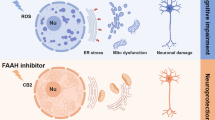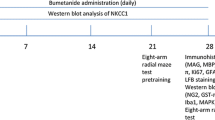Abstract
Chronic cerebral hypoperfusion (CCH) might account for the cognitive deficits associated with vascular cognitive impairment, but the mechanisms of hypoperfusion insulting to the cognition remain obscure. In the present study, Wistar rats underwent permanent occlusion of bilateral common carotid arteries to induce CCH. 2D-DIGE combined with MALDI-TOF MS was applied to determine the proteins that were differentially expressed in synaptosomes of prefrontal cortex and hippocampus. ATPsynβ, NDUFS1, UQCRC1 and Hsp70 were elevated both in synaptosomes of cortex and hippocampus at week 2 after operation, but subsided to baseline at week 4 except ATPsynβ which was still upregulated in synaptosomes of hippocampus at week 4. IDH3A and PDC-E2 were increased, respectively, in synaptosomes of prefrontal cortex and hippocampus at week 2, and showed no difference when compared to control at week 4. Malate dehydrogenase showed no difference in synaptosomes of prefrontal cortex and hippocampus at week 2, but showed an elevation in synaptosomes of prefrontal cortex at week 4. Our results imply that metabolic reserve and anti-oxidative stress might transiently exist in the early stage of CCH, which probably help cognitive save.



Similar content being viewed by others
Abbreviations
- CCH:
-
Chronic cerebrovascular hypoperfusion
- VCI:
-
Vascular cognitive impairment
- 2VO:
-
Permanent occlusion of bilateral common carotid arteries
- VaD:
-
Vascular dementia
- MCI:
-
Mild cognitive impairment
- LTP:
-
Long-term potential
- 2D-DIGE:
-
Two-dimensional difference gel electrophoresis
- MALDI-TOF MS:
-
Matrix-assisted laser desorption ionization time of flight mass spectrometry
- ATPsynβ:
-
ATP synthase beta subunit
- NDUFS1:
-
NADH dehydrogenase (ubiquinone) Fe-S protein 1
- IDH3A:
-
Isocitrate dehydrogenase 3 (NAD+) alpha precursor
- UQCRC1:
-
Ubiquinol-cytochrome c reductase core protein 1
- PDC-E2:
-
Dihydrolipoamide acetyltransferase
- MDH:
-
Malate dehydrogenase
References
Moorhouse P, Rockwood K (2008) Vascular cognitive impairment: current concepts and clinical developments. Lancet Neurol 7(3):246–255
Robishaw C, Beadle M (2010) Vascular dementia. US Pharm 35(1):46–48
Roman GC (2005) Vascular dementia prevention: a risk factor analysis. Cerebrovasc Dis 20(Suppl 2):91–100
Bakker FC, Klijn CJ, Jennekens-Schinkel A, Kappelle LJ (2000) Cognitive disorders in patients with occlusive disease of the carotid artery: a systematic review of the literature. J Neurol 247(9):669–676
Sekhon LH, Morgan MK, Spence I, Weber NC (1994) Chronic cerebral hypoperfusion and impaired neuronal function in rats. Stroke 25(5):1022–1027
Ni J, Ohta H, Matsumoto K, Watanabe H (1994) Progressive cognitive impairment following chronic cerebral hypoperfusion induced by permanent occlusion of bilateral carotid arteries in rats. Brain Res 653(1–2):231–236
Ohta H, Nishikawa H, Kimura H, Anayama H, Miyamoto M (1997) Chronic cerebral hypoperfusion by permanent internal carotid ligation produces learning impairment without brain damage in rats. Neuroscience 79(4):1039–1050
Tanaka K, Wada N, Ogawa N (2000) Chronic cerebral hypoperfusion induces transient reversible monoaminergic changes in the rat brain. Neurochem Res 25(2):313–320
Scheff SW, DeKosky ST, Price DA (1990) Quantitative assessment of cortical synaptic density in Alzheimer’s disease. Neurobiol Aging 11(1):29–37
Terry RD, Masliah E, Salmon DP, Butters N, DeTeresa R, Hill R, Hansen LA, Katzman R (2004) Physical basis of cognitive alterations in Alzheimer’s disease: synapse loss is the major correlate of cognitive impairment. Ann Neurol 30(4):572–580
DeKosky ST, Scheff SW (2004) Synapse loss in frontal cortex biopsies in Alzheimer’s disease: correlation with cognitive severity. Ann Neurol 27(5):457–464
Coleman PD, Yao PJ (2003) Synaptic slaughter in Alzheimer’s disease. Neurobiol Aging 24(8):1023–1027
Selkoe DJ (2002) Alzheimer’s disease is a synaptic failure. Science 298(5594):789–791
Scheff SW, Price DA (2001) Alzheimer’s disease-related synapse loss in the cingulate cortex. J Alzheimers Dis 3(5):495–505
Arendt T (2009) Synaptic degeneration in Alzheimer’s disease. Acta Neuropathol 118(1):167–179
Wilkins MR, Pasquali C, Appel RD, Ou K, Golaz O, Sanchez JC, Yan JX, Gooley AA, Hughes G, Humphery-Smith I, Williams KL, Hochstrasser DF (1996) From proteins to proteomes: large scale protein identification by two-dimensional electrophoresis and amino acid analysis. Biotechnology (NY) 14(1):61–65
Anderson NL, Anderson NG (1998) Proteome and proteomics: new technologies, new concepts, and new words. Electrophoresis 19(11):1853–1861
Khanna R, Zougman A, Stanley EF (2007) A proteomic screen for presynaptic terminal N-type calcium channel (CaV2.2) binding partners. J Biochem Mol Biol 40(3):302–314
Zhang L, Chang M, Li H, Hou S, Zhang Y, Hu Y, Han W, Hu L (2007) Proteomic changes of PC12 cells treated with proteasomal inhibitor PSI. Brain Res 1153:196–203
Tsuji T, Shiozaki A, Kohno R, Yoshizato K, Shimohama S (2002) Proteomic profiling and neurodegeneration in Alzheimer’s disease. Neurochem Res 27(10):1245–1253
Kunej T, Wang Z, Michal JJ, Daniels TF, Magnuson NS, Jiang Z (2007) Functional UQCRC1 polymorphisms affect promoter activity and body lipid accumulation. Obesity (Silver Spring) 15(12):2896–2901
Reed TT, Pierce WM, Markesbery WR, Butterfield DA (2009) Proteomic identification of HNE-bound proteins in early Alzheimer disease: insights into the role of lipid peroxidation in the progression of AD. Brain Res 1274:66–76
Bubber P, Haroutunian V, Fisch G, Blass JP, Gibson GE (2005) Mitochondrial abnormalities in Alzheimer brain: mechanistic implications. Ann Neurol 57(5):695–703
Hartl FU, Martin J, Neupert W (1992) Protein folding in the cell: the role of molecular chaperones Hsp70 and Hsp60. Annu Rev Biophys Biomol Struct 21:293–322
Beere HM, Wolf BB, Cain K, Mosser DD, Mahboubi A, Kuwana T, Tailor P, Morimoto RI, Cohen GM, Green DR (2000) Heat-shock protein 70 inhibits apoptosis by preventing recruitment of procaspase-9 to the Apaf-1 apoptosome. Nat Cell Biol 2(8):469–475
Lee KS, Chung JH, Oh BH, Hong CH (2008) Increased plasma levels of heat shock protein 70 in patients with vascular mild cognitive impairment. Neurosci Lett 436(2):223–226
Acknowledgments
This work was supported by the National Natural Science Foundation of China (Grant 30770756).
Author information
Authors and Affiliations
Corresponding author
Additional information
H. N. Zhang and J. Wu contributed equally to this work.
Rights and permissions
About this article
Cite this article
Zhang, H.N., Wu, J., Jin, T. et al. Transient elevation of synaptosomal mitoenergetic proteins and Hsp70 early in a rat model of chronic cerebrovascular hypoperfusion. Neurol Sci 34, 471–477 (2013). https://doi.org/10.1007/s10072-012-1063-4
Received:
Accepted:
Published:
Issue Date:
DOI: https://doi.org/10.1007/s10072-012-1063-4




